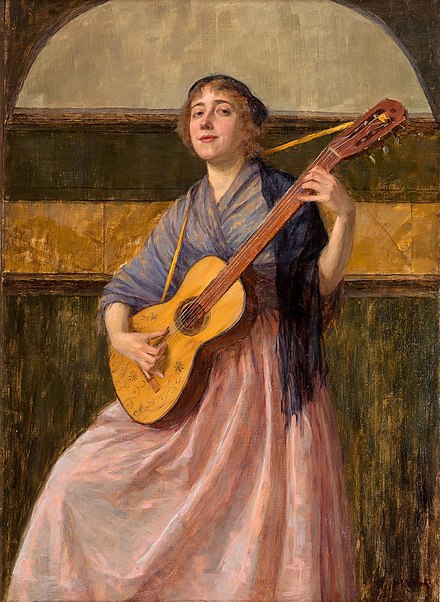Facts for Kids
A ballad is a form of verse that tells a story, often set to music, and can explore various themes and emotions.
Overview
Themes And Motifs
History Of Ballads
Structure And Form
Cultural Significance
Famous Ballad Examples
Ballads In Modern Music
Regional Variations Of Ballads
Techniques For Writing Ballads
Comparison With Other Poetic Forms
Influence On Literature And Storytelling

Inside this Article
United States
Taylor Swift
Middle Ages
Robin Hood
Literature
Narrative
Community
Memories
Singing
Musical
Scheme
Did you know?
🎶 A ballad is a special type of poem that tells a story.
🌟 Ballads have been around since the Middle Ages, around the 15th century.
🌈 They are usually written in sets of four-line stanzas called quatrains.
💔 Common themes in ballads include love, adventure, and tragedy.
🏹 One of the oldest known ballads is 'Barbara Allen,' from the 17th century!
🎤 Many popular songs today, like those by Taylor Swift, are inspired by ballads.
📜 Ballads often have a catchy rhyme and musical structure.
🤝 They help preserve history and cultural traditions in many communities.
📖 Famous ballads can express a wide range of emotions and stories.
🎊 There are many regional styles of ballads with unique cultural influences.
Introduction
People enjoy singing ballads because they are catchy and easy to remember! 🌈
Some famous ballads can be found in different cultures, and they help tell the history and emotions of those times. Let’s dive into the wonderful world of ballads! 📜
Themes And Motifs
These themes help people connect with the emotions and experiences of others throughout history. 📖
History Of Ballads
People would sing ballads to share stories in places like England and Scotland. One of the oldest known ballads is "Barbara Allen," which dates back to the 17th century! 🎤
As more people traveled and cultures mixed, ballads started appearing in different languages and regions. They were often passed down from one generation to another, helping to keep stories alive. 🕰
Over time, they transformed into different styles, but the heart of storytelling remained strong! ❤
️
Structure And Form
Three lines rhyme in a ballad, making it easier to remember and sing! Often, there's a repeated line or refrain, like in "Row, Row, Row Your Boat." 🎶 Ballads can also switch between specific rhythms, known as meter. Most ballads have a mix of stressed and unstressed syllables. This gives them a musical feel. 💃
So, if you want to write a ballad, remember the four lines and a catchy rhythm! 📝
Cultural Significance
They not only entertain but also preserve history and traditions. For example, Native American ballads often share stories of nature and spiritual beliefs. 🌳
In Ireland and Scotland, ballads help keep their unique histories alive, sharing tales of heroes and epic battles. 🏰
Similarly, in Africa, music and storytelling combine in powerful ballads that express community values. Through their enchanting melodies and relatable stories, ballads create a sense of belonging and cultural identity for many people! 🤝
Famous Ballad Examples
There’s also “Oh My Darling, Clementine,” which is both a fun and a sad tale about love and loss. 🎵
For a more modern example, think of "Someone Like You" by Adele; it has a ballad style with its emotive storytelling! 🎤
Each of these ballads captures strong feelings and vivid imagery, inviting listeners to dive into their stories. 🌈
Ballads In Modern Music
Artists like Taylor Swift and Ed Sheeran write songs that tell heartfelt stories, making them modern ballads. 🌟
For example, Swift’s “All Too Well” captures emotions and unforgettable moments, just like the classic ballads of old. 🎤
Some of these songs even use the traditional four-line verse structure! Ballads have adapted to different musical styles, including pop, rock, and country. 🎸
By mixing old and new, modern ballads continue to captivate audiences and help express emotions in unique ways. 🌈
Regional Variations Of Ballads
In the Appalachian region of the United States, you might find mountain ballads that tell stories of rural life, while in the Spanish-speaking world, they create ballads called "romances" that often feature romance and historical events. 💃
In the Caribbean, ballads can reflect a rich mix of cultures through rhythms and melodies. 🎵
In Africa, you may encounter epic ballads performed with drums and instruments, creating a lively atmosphere! 🎶
Each region’s unique twist keeps ballads vibrant and alive! 🎉
Techniques For Writing Ballads
Think about emotions like love, adventure, or a brave act. Then, write in quatrains, keeping the stanzas to four lines. ✍
️ Use a rhyme scheme, like AABB, where the first two lines rhyme, and the next two lines rhyme! Add a catchy refrain to repeat, just like in a song. 🎶
Finally, don’t forget to be creative with your words and make it sound musical! 🎼
Remember, the best ballads come from the heart, so let your feelings shine! 💖
Comparison With Other Poetic Forms
Sonnets have 14 lines and follow a specific rhyme scheme, while haikus are three lines that focus on nature. 🌸
Ballads are more narrative, meaning they tell a story, whereas sonnets and haikus often focus on specific emotions or images. 🖼
Ballads also usually have a musical aspect that invites singing! 🎶
While all these forms are lovely, ballads stand out for their adventurous tales and ability to connect people across generations. 🌍
So, each form of poetry has its unique spark!
Influence On Literature And Storytelling
Many writers, such as Shakespeare, were influenced by the rhythm and themes found in ballads. 🌟
Storytellers use ballad techniques to create captivating tales that draw in their audience. 🧐
Even movies and plays often borrow the storytelling style of ballads to convey emotions and adventures. 🎬
Overall, ballads have shown that storytelling can be fun, exciting, and a fantastic way to share experiences across culture and time. So next time you hear a ballad, remember, it’s more than just a song; it’s a powerful story! 📖✨

